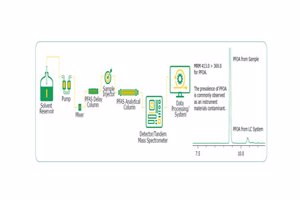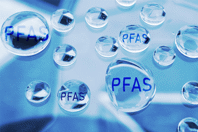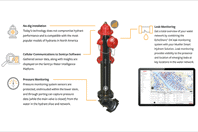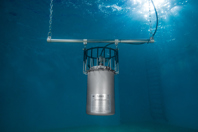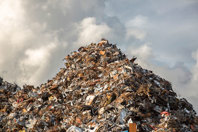WATER INDUSTRY FEATURES, INSIGHTS, AND ANALYSIS
-
PFAS In Pregnant Women's Drinking Water Puts Their Babies At Higher Risk, Study Finds
When pregnant women drink water that comes from wells downstream of sites contaminated with PFAS, known as “forever chemicals,” the risks to their babies’ health substantially increase, a new study found. These risks include the chance of low birth weight, preterm birth, and infant mortality.
-
PFAS Settlements: Debunking The Myths And Revealing What's Really At Stake For Water Utilities Misinformation and confusion could prevent some utilities from benefitting from the aqueous film-forming foam multidistrict litigation (AFFF MDL) settlements. Here are five common myths about the AFFF MDL PFAS settlements and how public water systems can make the most of this unprecedented funding opportunity.
-
When Chemistry Meets Water Innovation
Nobel-winning molecular materials are poised to reinvent purification, desalination, and reuse.
-
Solving The World's Microplastics Problem: 4 Solutions Cities And States Are Trying After Global Treaty Talks Collapsed
Microplastics seem to be everywhere — in the air we breathe, the water we drink, the food we eat. Countries have tried for the past few years to write a global plastics treaty that might reduce human exposure, but the latest negotiations collapsed in August 2025. While U.S. and global solutions seem far off, policies to limit harm from microplastics are gaining traction at the state and local levels.
-
AEC System Proven Effective For Chloride Removal
In two bench-scale tests, a new technology effectively removed up to 99% of chlorides and 97% of total dissolved solids in a single pass. This solution offers a commercially viable alternative to traditional treatment methods.
-
Common Misconceptions Are Keeping Lakes "Sick"
Long-held misconceptions about lake management fuel the intensity and recurrence of harmful algal blooms.
-
Colorado's Subalpine Wetlands May Be Producing A Toxic Form Of Mercury — That's A Concern For Downstream Water Supplies
The wetlands found across the Rocky Mountains of Colorado just below tree line are crucial for regulating the supply of clean water from the highlands to metropolitan regions downslope, including Denver. However, new research shows the wetlands also harbor a health risk.
-
Grand Canyon's Dragon Bravo Megafire Shows The Growing Wildfire Threat To Water Systems
As wildfire crews battled the Dragon Bravo Fire on the Grand Canyon’s North Rim in July 2025, the air turned toxic. A chlorine gas leak had erupted from the park’s water treatment facility as the building burned, forcing firefighters to pull back. The water treatment facility is part of a system that draws water from a fragile spring. The fire also damaged some of the area’s water pipes and equipment.
-
What Are Legionella Log Books And Why Are They Important? Implementing and managing a Legionella control regime can sometimes seem daunting and complex. Invariably, a lot of resources, time, and effort are needed to achieve the required standard and provide assurance to senior management and auditors that controls are effective and those that are not are being managed and rectified appropriately.
-
How ABB's Flow And Digital Technologies Help Bawat With Smarter Ballast Water Compliance
The International Maritime Organization (IMO) sets strict global standards for ballast water management to prevent the spread of harmful aquatic organisms. For companies like Bawat, a Danish innovator in ballast water management, being able to verify ballast water flow measurements quickly, accurately, and from anywhere in the world is essential.
VIEWS ON THE LATEST REGS
-
With the U.S. EPA's PFAS rules now in place, utilities are finding themselves with a growing number of questions regarding how to treat these chemicals, the potential costs, and much more. For answers, Water Online's chief editor, Kevin Westerling, hosted an Ask Me Anything session featuring Ken Sansone, Senior Partner at SL Environmental Law Group; Kyle Thompson, National PFAS Lead at Carollo Engineers; and Lauren Weinrich, Principal Scientist at American Water.
-
A Q&A to explain and resolve issues confronting water suppliers as they endeavor to comply with the monitoring requirements of federal PFAS regulations.
-
Assessing what lies ahead in the 10-year race to go lead-free, otherwise known as the Lead and Copper Rule Improvements (LCRI).
-
Many water systems are still tackling the challenge of identifying and compliantly managing galvanized and galvanized-requiring-replacement (GRR) service lines.
-
In the most recent edition of Water Innovations, there is not a single article focused on PFAS. That wouldn't be exceptional if not for the fact that discussion around per- and polyfluoroalkyl substances has so thoroughly dominated the water space lately. And yet, I penned this as an intro to the edition — just "a tiny bit of PFAS" content — because a small portion of PFAS is of the utmost importance in terms of treatment, policy, and cost.
MORE WATER INDUSTRY FEATURES
-
Biodegradable polymer microspheres control drug release through crystalline and amorphous properties, analyzed using DSC, MDSC, and TGA to determine composition and stability for precise delivery.
-
Chlorine sensor waste streams cause massive water loss and costs. The Halogen MP-5 sensor eliminates waste, reduces maintenance, and improves efficiency—offering a breakthrough in sustainable water monitoring.
-
The Circular Water Economy is built on the so-called six Rs: "Reduce," "Reuse," "Recycle," "Reclaim," "Recover," and "Restore". The six elements represent different strategies aimed at sustainable water management and conservation.
-
Explore data demonstrating the effectiveness of a rapid screening-differential scanning calorimeter as well as its detection limits and the range of concentrations suitable for DSC analysis.
-
Keys to bring down the cost of PFAS treatment for operations with limited resources — or any operation using media filtration.
-
In the production of adeno-associated virus (AAV) vectors, cell lysis involves challenges addressed through high salt concentrations and a salt-tolerant endonuclease, enhancing titer and infectivity.
-
This white paper explores how advanced biological technologies — including MBBR, IFAS, SBR, and MBR systems — are transforming wastewater management in this sector.
-
With the right help, coping with workforce upheaval, the digital transition, and asset management can be an opportunity.
-
PFAS rules are shifting fast. Learn how utilities can futureproof treatment strategies with flexible designs, smart staging, and emerging technologies—avoiding stranded assets and staying ahead of tomorrow’s regulations.
-
Learn how scanners used for high resolution metrology measurements should be designed and tested for flatness of motion, particularly for atomic force microscopy (AFM).
-
Learn five essential best practices to maintain a sterile incubator shaker environment, from routine cleaning and humidity control to advanced HEPA filtration for reliable results.
-
Read this article for an overview of key advantages, as well as examples of how communities have achieved cost savings by moving towards above-ground systems.
-
In this article, take a look at a few non-traditional ROI considerations when thinking about a new technology purchase.
-
We talk a lot about ‘compliance’ but the reality is that compliance is complicated and changes over time. This series breaks down compliance requirements across the LCR and the proposed LCRI to help you understand the who, what, and when of compliance.
-
As public awareness of per- and polyfluoroalkyl substances (PFAS) grows, so too does concern over their widespread presence in our water, soil, food, and even our bodies. Rapid, on-site, or remotely operated detection of these “forever chemicals” is a crucial step to understanding the levels of PFAS within our systems.
-
Explore the results of a study focusing on the early stages of the CAR T cell workflow, specifically the initial washing of leukapheresis followed by the isolation of T cells.
-
Read about how mixers help prevent stratification, maintain consistent disinfectant distribution, and reduce sediment buildup, thereby mitigating public health risks associated with water storage.
-
Engineers and project managers must take a complete cradle-to-grave approach when considering which technologies to implement as well as which vendors to partner with for their PFAS solution.













